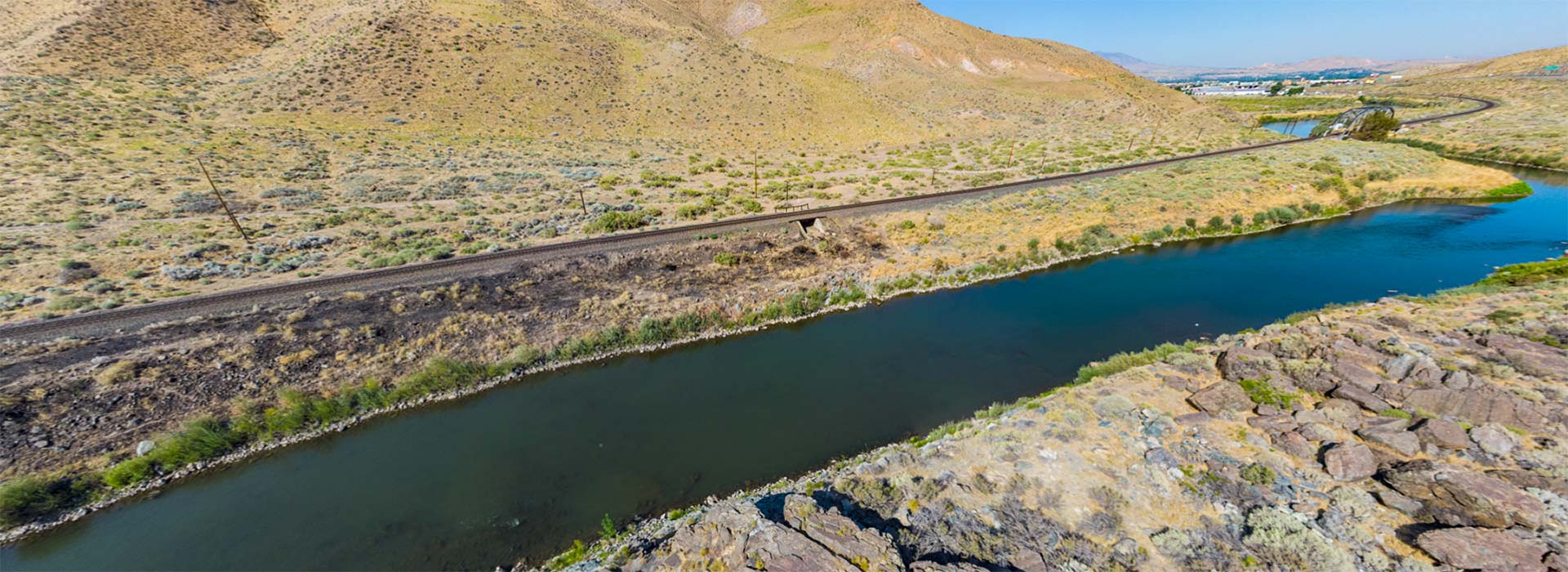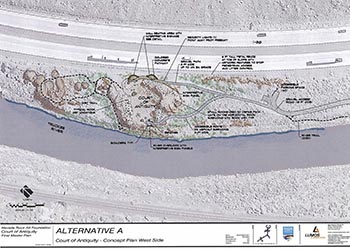
06 Sep The Court of Antiquity
Perhaps just a few hundred years ago, or perhaps more than 10,000, Native Americans gathered at this spot above the Truckee River to the east of the expansive meadows that would one day become the city of Reno. The riverbed would have been broader and shallower, a healthier habitat for fish and wildlife, before the channelization done by the Army Corps of Engineers in the 1960s. There would have been no interstate highway just above the rock shelf, since the precursor to I-80, the California Trail, would not appear alongside the river until the Gold Rush of the 1840s. Neither would there have been a railroad along the other side of the river; the Central Pacific did not reach Reno until 1868.
When the petroglyph panels comprising the Court of Antiquity were created this would have been a pristine location, where fish traps would funnel trout into reed baskets, and where hunters could hide within the rock crevices waiting for deer and antelope to come in range of their arrows, perhaps inscribing the panels of rock art while waiting for their prey.
Touch here for the HMD version.
In 2011 the Washoe County commissioners approved a plan to create a county park through a partnership with the Nevada Rock Art Foundation, the Washoe County Parks Department, and the Nevada Department of Transportation, in consultation with tribal authorities. The cost estimate was $2.8 million.
A site design (right) was created by the civil engineering firm Lumos & Associates in Reno.
It is unclear in 2018 why the proposed county park has not been built, as it would have protected and made accessible a unique cultural and educational resource within just a few miles of the Reno population centers.
With some civic determination, and the right funding sources, perhaps the project can be revived.





lb
Posted at 03:56h, 18 MayThis is one of my favorite local sites, both because of the ease of access and the irony that 40,000 people pass within 100 yards of this beauty every day completely oblivious to its existence.
Strange comment, PC. When we have visited the site numerous time, as late as 2022, it was not “totally trashed and vandalized.” Sure, lots of paper and plastic blow in from the refuse trucks heading to the Lockwood landfill, but the site hasn’t been heavily vandalized.. That is why whenever we visit, we bring in gloves, a couple big black plastic garbage bags, and spend some quality time cleaning up the site and hauling out as much of the wind blown trash as we can carry. I called the number on sign on the east entrance that says everything leaving the site must be logged and they said they were just fine with us hauling out the trash like this without logging it.
I challenge you to be part of the solution, rather than the problem, and spend some time/effort to clean up the site the next time you visit, rather than just sitting there crying “What a shame.” You will find that investing your time improving the site this way substantially increases your personal connection to this awesome historic site.
PC
Posted at 08:49h, 05 Aprilvisited the site, the other day, March of 2020. totally trashed and vandalized. What a shame. indigenous people, ceremonial site, for 1000’s of years totally destroyed in a matter of couple decades.
Leo Horishny
Posted at 14:24h, 08 SeptemberYes make this happen. Though it will expose the area to criminal damage, the majority of the residents need to learn about the idea that this area has been host to Americans for millenia.